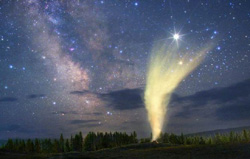
Yellow Stone National Park, USA by Wally Pacholka (TWAN Campaign)
The year 2009 is the International Year of Astronomy. The idea, proposed by the International Astronomical Union (AIU) and officially proclaimed by the 62nd General Assembly of the United Nations, celebrates the 400th anniversary of the observations by Galileo Galilei with his telescope back in 1609 and the publications of Johannes Kepler's Astronomia Nova in the 17th century.
Following the opening ceremony of the astronomy project that took place in Paris in January, many other functions related to the global project to celebrate astronomy are taking place worldwide in some 130 nations.
One of the global campaigns, the 100 hours of Astronomy Project (100HA) involves 24-hour observation of the night sky with 80 telescopes around the world. It took place in early April, covered by a live webcast (
www.astronomy2009.org).
The Galileo telescope project involves teaching how to use a telescope to at least 10 million people around the world, so that more people can enjoy more of the night sky. An ongoing project called "Make it happen" calls for donations to educate the general public about science and astronomy and alert the world about light pollution of the night sky.
Astronomy celebrations in Korea
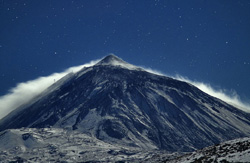
Canary Island, Spain by Juan Carlos (TWAN Campaign)
In Korea, the Korea Astronomical Society, the Korean Space Science Society and the Korean Amateur Astronomical Society are leading the way in a global starlit campaign.
Korea recently completed its celebrations of the 100 hours Astronomy Project from April 2 to 5, with the participation of astronomy departments from seven universities, 32 public and private astronomical observatories, two science museums, public libraries and camping sites.
Separately, the associations also set up a dedicated webpage in Korean (
www.astronomy2009.kr) to publicize the history of astronomy, information on space technology and the development of telescopes, together with forthcoming exhibitions, lectures and parties. Here are the major functions to come.
The next celebration is the
Kumdori Science Festival 2009 (April 10-12) at K-zone in Expo Park, Yuseong-gu Daejeon. The festival will have a commemoration ceremony, concerts, science quiz, observatory watch and sci-fi movies for the next three days at Science Expo Park, National Science Museum, Daejeon Education & Science Research Institute, Daejeon Public Observatory and other places. Children will particularly have fun with live space experience programs together with magic shows and contests. (These events are mostly Korean language only.)
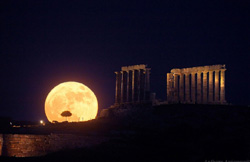
Cape Sounion, Greece by Anthony Ayiomemitis (TWAN Campaign)
will also open its celestial hall this coming weekend on April 11 and 12, to allow observation of the sun, to study the Seven Wonders of the Natural World, to provide a special lecture on astronomy followed by a concert.
The same museum is also holding an exhibition titled
“TWAN: The World At Night” that features exceptional photos of the night sky contributed by 29 professional photographers around the world, such as Fred Espenak in the United States, Babak A. Tafreshi in Iran and Aleksandr Yuferev in France.
On till April 26, the exhibition is part of a series of shows being held by U.S. non-profit organization Astronomers Without Borders. The same photos can be found on the TWAN homepage and
Naver, the most popular search engine in Korea. The website displays heavenly scenes of the night with sun, moon and stars against the backdrops of the mountains, forests and other familiar landmarks around the world, such as the Taj Mahal, the peaks of the Andes and the Parthenon in Greece.
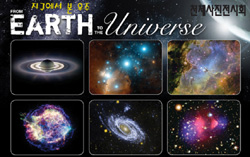
From Earth to the Universe (FETTU) Photo Exhibition
Separately, K-zone in Daejeon Expo Park will from April 10 to 12display photos of the 20 night sky taken by Korean astro-photographer Kwon O-chul. He further contributed six of his works to the above TWAN project.
Another photo exhibition titled From Earth to the Universe (FETTU) is also on display at
Goguryeo Astronomical Observatory (Korean) in Chungju city, Chungcheongbuk-do (North Chungcheong Province). A total of 20 pictures of the night sky captured by the Hubble Space Telescope and other observatories around the world will be displayed from April 7 to 22. The observatory is opened from 2 p.m. to 10 p.m. each day.
The photos will then be displayed at
Jangheung Jeongnamjin Observatory (Korean) in Jeollanam-do (South Jeolla Province) from April 23 to May 5. This observatory is also open from 2 p.m. to 10 p.m. For more information call 042-865-8763 (Korean) or e-mail (
star@daejeon.go.kr).
The organizing committee is preparing for events such as a Campus Starlight Festival in May, observation of the solar eclipse in July, Korea Science Festival in August, UN space technology workshop in September and Korea Starlight Festival in for October.
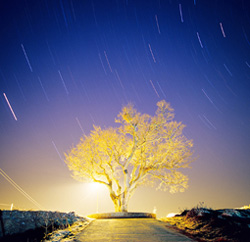
Anmyeondo Island, Korea by Kwon O-chul (TWAN Campaign)
Also in October, there's the
60th International Astronautical Congress in Daejeon from the 12th to the 16th. Titled “Space for Sustainable Peace and Progress,” there will be workshops, technical sessions, plenary speeches, lectures, fairs and news about all the latest in the field of astronomy.
People will be able to enjoy concerts, sci-fi movies and hands-on activities like a space playground.
Finally, SETI (Search for Extra-Terrestrial Intelligence) will be a highlight in November and in December a time capsule will be buried, containing present information on astronomy to be excavated in 2019.
For more information visit:
International Year of Astronomy 2009 official website:
www.astronomy2009.orgInternational Year of Astronomy 2009 Korean website:
www.astronomy2009.krBy Kim Hee-sung
Korea.net Staff Writer